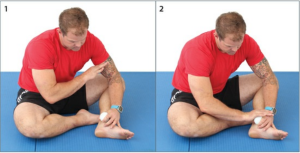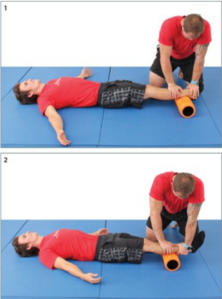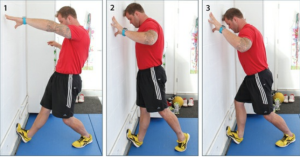Dip N' Drive
The Sport of Weightlifting
Monthly Archives: January 2014
Ankle Mobility
Posted by on January 31, 2014
Ankle inflexibility can be a huge inhibitor for beginner weightlifters. It’s something I’m struggling to fix with one of my two cubicle monkey clients: a tall, lanky former D1 tennis player.
While the traditional bootstrap method of sticking a small weight under the back of the shoe to elevate the heel and increase ankle range-of-motion can work, it’s far from ideal, and merely treats the symptom, not the disease.
Here is my own favorite ankle mobility method:
However my client can’t get his hip below parallel, so this option doesn’t work.
Instead, I’ve turned to Kellly Starrett’s MobilityWOD for help. Specifically, his book: Becoming A Supple Leopard. In the chapter titled ‘Area 13: Ankle and Plantar Surface’, Kelly offers a couple ideas for restoring ankle mobility.
Ball Whack
Does your skin slide over your anklebones and tendons? If it doesn’t, you should immediately recognize that as a problem and work on restoring sliding surfaces to that tacked-down skin. To use the ball whack to restore sliding surfaces to the skin over the bony prominence and tendons of your foot, pin a ball on the inside and outside of your anklebone and around the areas of the heel cord and give it a firm whack. This momentarily stretches the skin, peeling it off the underlying surfaces.
Although you can do this mobilization on your own, it’s difficult to generate sufficient force. For this reason, I advocate employing the help of a Superfriend.
 You can try this method on the inside ankle, heel cord, and outside ankle. Try multiple directions, until the skin starts to slide smoothly over the underlying surfaces.
You can try this method on the inside ankle, heel cord, and outside ankle. Try multiple directions, until the skin starts to slide smoothly over the underlying surfaces.
Calf Mobility
One of the points Kelly constantly reinforces is to think upstream and downstream of the issue you’re dealing with. Tight ankles? Mobilize your calves!
Two calf options are:
calf smashes with a foam roller – even better with a friend

foot-against-the-wall calf stretch
That’s enough from Kelly’s book. I really recommend you buy the book and see for yourself how useful it is. It’s half-off on Amazon and it’s definitely the book I most frequently consult in my day to day training.
Battle of the Squats
Posted by on January 30, 2014
I found this video floating around /r/weightroom. Basically, it’s a max bodyweight back squats in 5 minutes challenge among four competitors: a Weightlifter, a Powerlifter, a Strongman, and a Bodybuilder.
I’d love to see more of these kind of videos, comparing various strength sport athletes.
Basic bio for the participants:
Patrik, Strongman: Int. German Junior Champion Bodybuilding 1999 Germany’s Strongest Man 2011 World-records in: Loglift, Keglift, Yoke-Walk
Robert, Weightlifter: Multiple German Champion, placed 9th @European Championships 2013, placed 11th @World Championships 2013 all up to 69 KG – class
Dorian, Bodybuilder: 2xGerman Champion, World Championship – Finals, 4th @Frey Classic
Thomas, Powerlifter: Multiple Bench Press State Champion, Powerlifting State Champion, won an insignificant tug war battle @ basic military service – he insisted on this
Core Training for Weightlifting
Posted by on January 29, 2014
I recently bought Greg Everett’s Olympic Weightlifting: A Complete Guide for Athletes & Coaches. I’ve only scratched the surface of the material inside, but the book leaves me stunned by its detail and quality.
One of the first sections I read focused on core training; a needed priority for the two cubicle monkey athletes I train.
Before discussing the movements involved, it’s important to understand what core is:
The musculature of the mid to lower trunk that stabilizes and moves the spine.
In other words, not just your abs, but your back muscles too.
So what kind of exercises should a weightlifter prioritize to develop greater core strength? First of all, it’s important to note that all of the major weightlifting exercises and accessories work the core: snatches, clean and jerks, squats, pulls and presses all challenge and strengthen the core.
Beyond that, Greg recommends “prioritiz[ing] the function of static strength”. Below are some of the exercises recommended (for a full list, buy the damn book. It’s worth it):
Jerk Rack Support [video]
Best done in a power rack or on jerk blocks for safety, but can be done out of a squat rack. Lift the bar from the rack in a jerk rack position and hold for 2-5 seconds.
Hanging Leg Raise / Hold [video]
Though Catalyst instructs to “not allow your legs to bend”, realistically, a bent knee raise or hold is necessary for many beginning athletes. Additionally, full range of motion will be difficult for those with less mobility.
Back Extension Holds [video]
While back extensions are a well known exercise, back extension holds challenge and build that isometric strength even more. In his series of posts on his travels through China’s weightlifting gyms, Yatin Parasher mentioned Chinese coaches programming “6×1 min holds weighted preferably” for bodybuilding work.
Team Training Videos
Posted by on January 28, 2014
One of my favorite types of weightlifting videos to watch is team training videos.
There’s something about watching a large team of successful weightlifters working together that I always find inspiring and illuminating.
More than anything else, these videos make me wish I had a team to belong to, but that’s a post for another day.
My absolute favorite team to watch is California Strength. They post about two videos a week, the videos are good quality and it’s a nationally competitive team.
The best recent California Strength video that I’ve seen recently was actually a video of their warm-ups, that I felt I learned a lot from:
An even better team is Muscle Driver USA. Their videos are much less frequent, but they have better lifters, and more importantly, one of the athletes does commentary during the video, which is of course very helpful and insightful.
No one video sticks out to me as the best, but here is the most recent one:
Subscribe to their YouTube channels and hopefully you’ll get as much out of them as I do.
Have any suggestions for other teams to watch? Mention them in the comments.
First Meet Notes
Posted by on January 27, 2014
Previously, I wrote a post on advice from experts for your first weightlifting meet.
Here are some notes, post meet.
1) Pillow. The secret weapon. Best advice I got was from Jacob Tsypkin who wrote:
The absolute most important thing you can do at this time [between weigh-in and warm-ups] is try to stay relaxed (did you bring that pillow?)
Having a pillow, headphones, and A Feast For Crows on my phone was so helpful in staying relaxed and calm during the three and a half hours or so between weigh-in and warm-ups. I ended up lifting about an hour and twenty minutes later than I had planned. Instead of pacing and wasting adrenaline, I laid down in the back on my pillow, listened to my book, and breathed deeply. I was more relaxed than ever.
2) Use the clock. Another great piece of advice from the same article:
DO NOT rush your set-up. This is probably where I see the most new lifters miss their attempts – they get too excited and hurry through their set-up. Behave exactly as you would in training.
I probably took the longest to lift of almost anybody there, even though it was only fifteen seconds or so. I’d take setup on the bar, sit in the bottom of my squat, take deep breaths, stay relaxed and clear my mind, just like in training but a bit longer. I really think it helped. My heart was never beating fast, and my lifts felt instinctual. That is NOT how my lifts normally feel, given I’m an unathletic cubicle monkey (the last time I competed at something, I left bloody).
3) Use the night before to prepare. I packed my bag, made food and planned out my morning the night before, giving myself plenty of time for surprises. The next morning breezed and I never felt stressed. Just like the previous two notes, it all comes down to eliminating as many distractions and stresses as possible so you can simply focus on lifting.
Most importantly, have fun. Meet the other lifters, have someone to root for and vice versa, relax and enjoy it. Not only will it help you perform better, but you’ll have a better experience and want to come back.
I left a more thorough recap on Reddit with a lot of boring details you don’t care about.
School of Champions: Bulgarian Training Documentary
Posted by on January 24, 2014
Some weekend viewing thanks to the folks at All Things Gym. School of Champions: Bulgarian Training Documentary.
Bonus article: “Do It Yourself Bulgarian” by Jacob Tsypkin at JTS Strength.
Split Jerk vs Squat Jerk
Posted by on January 23, 2014
Did you know that split clean and split snatch used to be common? I had never even seen either one performed before until I started doing some research on the squat jerk. But that’s a topic for another day.
So what is the squat jerk? According to Jim Schmitz:
Done after a full squat clean, you dip and drive the barbell up and instead of splitting your legs fore and aft, you drop into a full squat with the barbell directly over your head and your feet widen just a little.
Here’s an example of 77kg world record holder Lu Xiaojun performing a 205kg squat jerk at the 2011 World Weightlifting Championships:
Here’s another example of the squat jerk, this time American Olympic athlete Kendrick Farris with a 215kg squat jerk in training:
So why choose the squat jerk over the more traditional split?
Well… I can’t find a good answer. Plenty of articles discuss the two. All make the standard acknowledgment that some world record holders squat jerk so it must work for them. But there doesn’t seem to be a clear and concise answer.
For example, Schmitz says: “I have asked the coaches of these squat jerkers why their lifters do it and they say that they have tried the traditional split jerk, but the squat jerk works best for them.”
Farris himself comments on his Facebook page that he squat jerks because 1) “How many exercises are we doing Splitting with a heavy load?” and 2) “How many times have you had a weight locked in (made) but lost it because of footwork?”
In a TechniqueWOD video, Doug Larson says that in order to squat jerk you need to have “very, very good mobility” and “a body type that will benefit from that jerk”, specially one with a “long back, short torso”.
In a forum post on Catalyst athletics, Josh Everett says the only advantage of the squat jerk is that “you do not need to lift the bar as high as you would for a split”.
Reading Greg Everett’s Olympic Weightlifting, he mentions nothing but disadvantages.
Finally, Kelly Starrett has an old video on MobilityWOD about the squat jerk and “identify[ing] where in the bottom position you feel restricted in your back” and how to fix it.
So bottom line, is the squat jerk for you? Probably not. If you’re a beginner lifter it probably can’t hurt to try both methods and see what feels more natural for you, but given the vast majority of lifters using the split jerk, that’s probably the way to go.
Slow Mo: Lu Xiaojun’s 176kg World Record Snatch
Posted by on January 22, 2014
Back Angle Off the Floor
Posted by on January 21, 2014
Spencer Arnold recently did a series of posts on preserving back angle off the floor. This is something I clearly struggle with.
One of my biggest struggles is not engaging my back muscles and keeping them tight throughout the entire movement. I tend to tighten my back at the start and allow it to flex as the bar leaves the ground.
This is exactly the same problem I run into as well. Getting the back set is all well and good, but if you lose that angle from the moment you begin your first pull, it’s not doing you much good.
So what can we do to correct this problem?
Spencer lists five corrective exercises to try, including pauses at the knee, high pulls with tempo return, and some others.
I especially like the pauses because they reinforce the proper positioning while giving you time to make sure you’re in the right position. For desk jockey’s like me who aren’t as naturally athletic as more gifted lifters, really feeling those positions and being able to see how they look in a mirror at the pause is very helpful.
Additionally, the isometric hold and additional time under tension help build strength and hypertrophy, an added benefit for those of us who, as Jacob Tsypkin once put it, “figured out that you’re more likely to look like Klokov than lift like Klokov”.
Gear for a New Weightlifter
Posted by on January 20, 2014
Simple question: What stuff does a new weightlifter need to buy?
Note I used all Rogue links to keep it easy if you want to buy a bunch of stuff all from one place. They also do free shipping on a lot of stuff. I’m not paid by them or anything like that. There’s definitely some cases where I wouldn’t buy the Rogue links, like the notebook or timer.
NECESSARY the stuff that can’t be skipped
Weightlifting Shoes – The very first purchase should be weightlifting shoes. Everything else can arguably wait but this should be the first thing.They aid your lifts and squats a great deal, and more importantly, you don’t want to ingrain bad motor patterns if you start learning the lifts without weightlifting shoes. If you don’t want to spend a lot of money, there are cheaper options out there that don’t require the same high dollar price commitment. I bought a pair of the Rogue Do-Win ($119) shoe and have been using them for over a year. I just bought a new pair of Nike Romaleos 2 ($189) but I’m not switching until after my first meet next Sunday. A lot of people also like the Adidas Adipower ($199), including seemingly every American weightlifting video I see.
DAILY USE the stuff i use every day
Notebook / Pen – Writing down your workouts promotes discipline and offers a guide to what worked and didn’t work in the past. I just use a plain spiral bound notebook but if you want to keep more detailed track of your progress, this Rogue Fitness WODbook ($16.50) is meant for CrossFit but it could work for weightlifting.
Stop Watch or Timer – I find that using specific rest periods between sets, rather than just going by feel, is beneficial to make sure I spend my limited time well in the gym. Rogue sells this Robic Timer ($24) but there are much better options, including your phone.
Lifting Straps – Not quite every day, but just about. When you’re doing heavy clean and snatch pulls, your grip shouldn’t be the limiting factor in how much weight you can do. I have a pair of these Rogue Lifting Straps ($12) that work well for me.
Hand Care – Tearing a callous hurts like hell and impedes your training for days. After getting plenty in CrossFit, I made sure to take care of my hands once I started weightlifting. RIPT Skin Systems has a Fix Your Hands ($22) pack that has a grind stone to use in the shower after every training session, a stick you apply daily to keep your callouses soft, another stick for freshly ripped callouses just in case. I haven’t had any problems after I bought the pack and started using it, so I’m a fan.
IT DEPENDS the stuff not everyone needs
Knee Sleeves – I wear a pair of Rehband 7751 ($74) for any workout where I’m going heavy below parallel. When my knees are really bothering me every couple of months, I switch to the heavy duty Tommy Kono ($40) bands. Plenty of people lift without knee sleeves and don’t have knee pain, but I feel better wearing them every workout.
Wrist Wraps – I use a pair of Rogue Wrist Wraps ($15) on any heavy overhead work, including heavy snatches and jerks. Again, not everyone uses or needs these, but I feel better with them on.
Chalk – Most weightlifting gyms should have this available, but if you’ll be lifting somewhere without it, this is a good option for a travel chalk that you can stick in your bag. I have a Bison Chalk Ball ($13) for the rare occasion it’s needed. Also good for meets when you don’t know what will be available and where in the warm-up area.
Mobility Accessories – Most weightlifting gyms will have at least some of this stuff, but again, I have my own copies to keep in my bag or at home. A lacrosse ball ($3), a stretch band ($20), and a foam roller ($40) should be enough.



Recent Comments